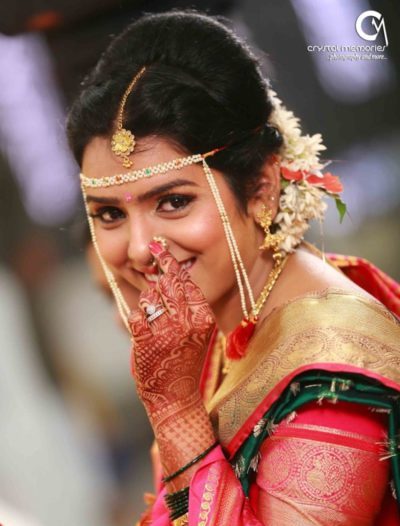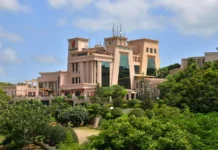Simple and sober with no extravaganza- that’s the Maharashtrian way of saying ‘I do.’ The wedding is more ritualistic in nature and morning glory marks the advent of nuptial ceremonies. Here’s beckoning to a new dawn, new day and telling you all about a Marathi lagna and the multitude of rituals embedded in it!

Maharashtrian wedding is a melange of colorful vibrancy and gaiety. The premise that ‘marriages are made in heaven’ is ratified in this culture, only if the grahas (stars) are in unison. Lagnaach bedi or finding a suitable match is the first step. Once the respective families come to a mutual agreement on the match, the supremely delicate task of ascertaining the compatibility of their stars takes on vital significance. The patrikas (horoscope) of the boy and the girl are shown to the family pundits for their consideration. The respective brahmins deliberate on all the relevant features of guna milan (matching points). If 16 or more gunas match, only then can the boy and girl tie the knot. Once it has ben determined that the two horoscopes are in total sync, the actual process of the wedding begins.
Baithak, as the name suggests, is a semi-formal meeting of the elders of the two families. The parents and close relatives get together to discuss the various issues regarding the marriage. It is here that the actual mahurat (auspicious day and time) for the marriage ceremony is decided.
PRE- WEDDING RITUALS
Shakarpuda
Shakarpuda is engagement ceremony, wherein marriage is confirmed. Family members, relatives, friends & well wishers get together usually at brides place or at a place mutually agreed by both families & Sakharpuda vidhi is performed by Pandit on an auspicious day suitable to bride & groom.
Bride & the groom exchange rings as a token of the engagement. In addition, clothes & jewelry are also presented by both families to each others.
It is the beginning of a new relationship between the two families.
Kelvan
Wang nishchaya is the formal engagement ceremony. Kuldevta, i.e., the devotee is worshipped in the house of both the families separately. The close relatives and friends call over bride and groom and their respective family members for a meal and give them gifts. This is usually done before 3-4 days of marriage.
Halad Chadvane
This is yet another custom special to Maharashtrians. The bridegroom and the bride have their own celebrations in their respective homes. Women from each family get together to apply a mixture of turmeric, sandalwood and cream to the face and body of the bridegroom or the bride. The young person to be married then has a ceremonial bath and is not allowed to go out of the home after this ceremony. Haldi is considered a purifier and is an antiseptic substance.
Seemant Puja
Literally meaning ‘boundary worship’, it was originally performed when the groom crossed the border of the bride’s village. Nowadays, seemant puja is performed in a temple on the marriage day. A “Seemaan pooja” (the boy’s family crosses the Seema or limits of the girl’s residence) is conducted.
The bride’s parents wash the feet of the boy, his parents and traditionally the womenfolk of his family and generally welcome the bridegroom. He is offered a seat on a decorated “Chaurang” (pronounced “tsow-rang“, a low square stool). At this point, any gift/s that the girl’s parents wish to give to the boy are handed over. Ring, watch, gold chain etc. are usual gifts. The boy also gets silverware (plates, glasses, bowls, spoons etc.), which may be used immediately in the meal that follows.
The bride’s mother then washes the feet of the groom’s mother and performs an oti-bharan ceremony for her as well as for the other female relatives of the groom and give them gifts.
WEDDING DAY RITUALS
Ganpati Puja
First the propitiatory rites are performed. Every auspicious samskara begins with the worship of Lord Ganesh in the morning, where close relatives and friends invoke the deity, inviting His presence with betel nut and a handful of rice grains. The worshippers bow before the Lord and beseech Him to grace the occasion and make it free from obstacles. Thus, no ceremony or festivity in a Maharashtrian household is initiated without first invoking the benedictions of this most beloved God. This is followed by Punyavachana and Matruka Pujana or holy day blessing and worship of the Matrus (seven mother goddesses).
Vraprasthana
The boy’s party goes in a procession to the girl’s place where Suvasinis (married women) greet the boy by waving a lighted lamp. He is then led into the marriage hall to sit on a Chouranga (low square stool).
Gowrihar Puja
While the bridegroom eats, the bride is in another room performing a Gowri-har pooja of the Devi, whose likeness is kept on the bride’s Chaurang. She is brought in for the antarpat by her Mama (mother’s brother). She wears a yellow sari and green glass bangles. She also wears a Sehra (flower or pearl arrangement around the head, like a crown, with loose strings hanging on the sides of the temples.)
Mangalashtakas
The ceremony begins with the bridegroom standing and facing the east, while an antarpat (silk waist-cloth) with a swastika mark is held in front of him. The bride adorned with jewellery, flowers and perfume and draped in a beautiful shalu (wedding saree), is then brought by the maternal uncle to the pandal amidst chanting of mantras and shlokas by the Brahmins, to stand opposite the groom with the antarpat between them. Both the bride and the groom hold garlands while the priest chants managalashloka. When the auspicious moment arrives, the antarpat is withdrawn towards the north, and as the musicians start playing on the instruments, the guests shower akshatas (colored rice) on the couple. The vadhu garlands her var, gives him a bouquet of flowers and touches his feet to seek his blessings. The var then garlands his bride. Then five married women, suvasinis, from both the families come forward and perform an arti on the newly-weds.
Lajahoma
This is performed after igniting the sacrificial fire. The bride makes three offerings of lahyas (parched grains) while mantras are repeated by the groom. The fourth and the last is made by the bride silently. The couple takes mutual oaths before fire, earth, priest and gods that they will be each other’s partners throughout life for better or for worse. It is now that the groom places the mangalsutra (gold chain with black beads) around the bride’s neck, proclaiming that she belongs to him. He then puts jodave (toe-rings) on her toes. Then he places sindoor (vermilion mark) on her forehead. All these are symbols of a married lady and are very precious to her.
Next, the groom is made to stand behind the bride. With their hands touching, they offer lhaya (dried rice) to the sacred fire. The bride’s brother puts some into her hands, assuring her that even in bad times he will be there for her. He then performs the kaanpilne wherein he pulls his new brother-in-law’s ears as a mock warning that he better take care of his sister or else!
Saptapadi
The marriage becomes final and irrevocable when the ritual of saptapadi (seven steps) is performed. In this ritual seven small heaps of rice with a betel-nut, are arranged around the altar and the sacrificial fire rekindled. The bridegroom leads the bride, putting her right foot on the rice heaps one by one at each step, while the priest chants sacred verses. Then the couple offer parched grains and ghee to the fire.
Lakshmi Pujan
Now the couple perform the Lakshmi Poojan where they pray to Goddess Laxshmi and then the groom is asked to give a new name to his wife, which he writes on the rice with a gold ring.
After the Saptapadi the bride and groom bow to the Pole Star with folded hands which is symbolic of their firm determination to observe constancy of the marital vows throughout life.
The wedding rituals conclude with the Varat (bridal procession). The Grihapravesh (bride entering her new home), the Devakotthapana (taking leave of the deities) and the Mandopodvasana (dismantling of the marriage pandal).
POST WEDDING RITUALS
Griha Pravesh
The first ritual for the bride as she crosses the threshold of her new home is as old as the Deccan hills. The bridal house is festooned with mango leaves and marigolds. The bride lifts her pretty henna’d foot and gently kicks a wooden measure piled high with grains of rice. The grains spill over and scatter inside the living room door. At this moment, the bride is supposed to be an incarnation of Lakshmi, the goddess of wealth, bringing to the family fortune, as symbolized by the rice grains spilling inside the marital home.
Halad Utravane
Next day in the morning, five suvasinis do the same process as halad chadvane but in reverse order. This is to signify that now the couple is free to go out. The groom’s mother unties the kankan-halkund tied on the hands of the bride and groom. This ritual is followed by reception, which culminates the elongated Maharashtrian wedding ceremonies.
Also read: https://weddingaffair.co.in/the-upcoming-wedding-season-saya-calendar-is-here/









